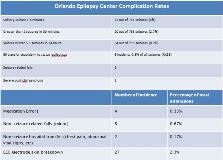The Outpatient Epilepsy Monitoring Unit: A New Model for the EMU
Abstract number :
2.382
Submission category :
13. Health Services (Delivery of Care, Access to Care, Health Care Models)
Year :
2018
Submission ID :
499188
Source :
www.aesnet.org
Presentation date :
12/2/2018 4:04:48 PM
Published date :
Nov 5, 2018, 18:00 PM
Authors :
Kristen Batson, Orlando Epilepsy Center and Ahmed Sadek, Orlando Epilepsy Center
Rationale: The epilepsy monitoring unit (EMU) is the known gold standard in assisting in verification of epilepsy diagnosis, classifying epilepsy type, and assisting in localization during pre-surgical evaluation. This study examines the outpatient EMU as a safe and equivalent model with added patient comfort and convenience. Methods: Data from a consecutive cohort of patients admitted over a period of 5 years (2011-2016) from an outpatient EMU were retrospectively reviewed. Information regarding patient demographics (sex, age, length of admission) and seizure data were collected (number of seizures, duration of seizure, time to RN response, withdrawal of anti-epileptic drugs, and classification of seizure type). In addition, patient charts and facility incident reports were reviewed for details of adverse events. Both adverse events regarding seizure complications (prolonged seizure, seizure related injury, status epilepticus) and other adverse events (non-seizure fall, medical events requiring transport, medication errors, etc) were detailed. A comprehensive literature review was also conducted to help identify rates of complications and safety data in inpatient EMUs to serve as comparison. Results: Rates of adverse events (both seizure and non-seizure) related were analyzed and compared to literature of similar inpatient EMUs. Data revealed similar or lower rates of adverse events (overall < 1%) including status epilepticus (0.8%) and seizure cluster (8.7%) . Seizure response times were also quite low (mean of 38.08 seconds) compared to a previous study that noted 142 second average response time (Atkinson, et al.) Conclusions: Analysis of data revealed low rates of adverse events in an outpatient EMU indicating this is likely a safe and suitable alternative to the typical inpatient procedure. Utilization of this model could to lead to increased utilization of EMU without added hospital costs and increased patient comfort and quality care. Funding: None

.tmb-.jpg?Culture=en&sfvrsn=9e53ede6_0)